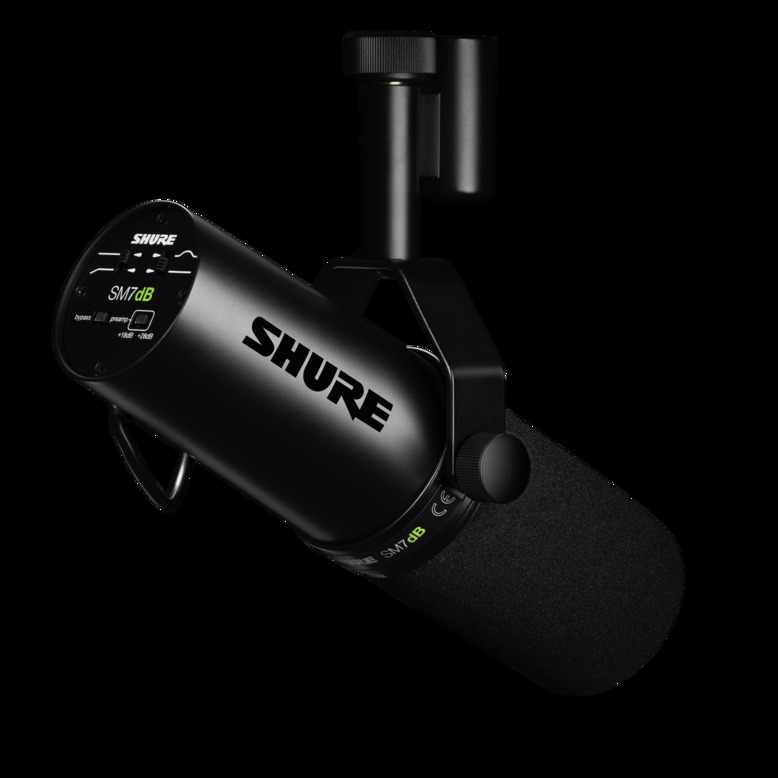Shure’s SM range of microphones is the absolute industry standard – used in every studio and on every stage around the planet. So why are these the holy grail? Why does every producer, engineer, broadcaster, artist and content creator swear by this iconic collection?
As you can no doubt guess, it’s because they are great. The best, by any measurable metric. But that’s just a given. What we really want to do is explore the finer details as to why the SM range is king of the castle.
To start with, let’s look at the big guns – the versatile workhorse models that find themselves absolutely everywhere – then work our way through the more purpose-built models.
SM57, SM58
Shure’s SM57 and SM58 microphones are hands-down the most loved, trusted and used microphones of all-time. Every gig you have ever seen, and every recording you have ever listened to, had SM57s and SM58s as their core arsenal – often with not a single other microphone in the stack.
The craziest thing about SM57 and SM58 microphones is that, depending on who you talk to, they are the go-to microphone for absolutely every single instrument. While there is not a snare drum on Earth that hasn’t had an SM57 pointed at it, a lot of top producers opt for the SM58 as a drum mic for its tonal complexity. And while the SM58 is the universal vocal mic of choice, some of the most iconic vocal recordings and performances have been through an SM57.
And onwards through the instrument range we go. Most live engineers will put an SM57 in front of a guitar or bass cab before any other microphone option is even considered. In the studio, where the fancier condenser and ribbon mics come out to play, an SM57 will still be front-and-centre of anything amplified through a speaker. And, as with drums and vocals, some of the greatest producers and engineers swear that the SM58 is the cab microphone.
So, beyond taste or personal preference, the truth is that you could indeed record or mic up a live band using only SM57s, SM58s or both. In fact, you can find videos and oral histories of producers and engineers doing just that, both as a challenge and a proof of concept that the SM siblings are both the ultimate and penultimate – in whichever order suits your predilection.
Love Music?
Get your daily dose of everything happening in Australian/New Zealand music and globally.
Thus, if you can only afford one microphone for recording, live performance or rehearsal, make it an SM57 or an SM58. If you can afford two; buy another. Mix and match, or build an armada of one or the other. You will never ever regret buying SM57s and SM58s, and you will never ever not need one.
Quality means reliability. Shure build the highest quality mics on Earth – not just in terms of sound, but also durability. Try finding a stage without a perfectly-functioning-yet-dented SM58 that has been dropped, mishandled or repeatedly slammed against some mad rocker’s forehead. That thing will still work for the next 50 years / 1,000 foreheads without a blip.

Image: SM7B Credit: Supplied
SM7B, SM7DB
Thanks to the global popularity of podcasting – and by extension its ancestor of radio broadcasting – we can safely say the Shure SM7B and newly-minted SM7DB have joined their 57/58 siblings as the most popular microphones in history.
If someone told you to close your eyes and picture the microphones used in your favourite podcast, it is almost 100% going to be a Shure SM7B. Is there even a close competitor? No. Broadcasters and content creators are equally as blessed with the SM7DB as they are with the SM7B – essentially the same microphone, just with the addition of a preamp in the SM7DB.
For studios with outboard gear like preamps, the SM7B is, and always has been, the be-all and end-all microphone. And now, in the content creation age where mobility matters, the SM7DB bypasses the need for bulky outboard preamps by giving you world-class gain control built in. Same tone, response, quality and look of the OG SM7B, but with one of the best preamps on the market built in.

Image: SM7dB Credit: Supplied
OK, OK… What Else Ya Got?
As much as the SM57, SM58, SM7B and SM7DB rightly steal the spotlight, Shure’s SM range doesn’t end there. Also in the ranks are some of the more unsung heroes that do equally impressive work, albeit without all the glory and attention of their more famous counterparts:
SM27
A brilliant cardioid condenser mic loved for its deep tonal range and low-noise response; the SM27 is one of those studio mics that will be all over a recording – firstly as one of the best and most versatile drum mics, secondly as a rich and detailed room mic, thirdly to capture the authentic tones of stringed acoustic instruments, fourthly as one of the deepest and most characterful bass cab mics, and then lastly as a primo vocal mic that rivals even the mega-bucks alternatives. If you’re into band recording, the SM27 is a Swiss Army Knife.
SM81
This unidirectional cardioid mic is most commonly used in a stereo pair, within which it can achieve an incredible stereo image (such as an ORTF configuration) or centred image (in an XY configuration). As such, the SM81 is perfect for overhead recording – seen in most studios placed over drums or pianos – but has a bass roll-off that also makes it perfect for proximity recording of instruments like guitar.
SM63, SM63L, SM63LB
Small, built super tough, focused on optimum speech intelligibility, and featuring a humbucking coil that cancels out hum fields; the omnidirectional SM63 range is the weapon of choice for people capturing on-location audio such as interviews. First and foremost, the SM63 is practical – portable, reliable, reducing plosives and cancelling unwanted frequencies – but that doesn’t mean it’s not also beautiful. The range has a shorter (SM63) and longer (SM63L) option, and comes in either a champagne or black (SM63LB) finish.
SM137
The SM137 was purpose-built to be the world’s best stage cardioid microphone for stringed acoustic instruments, and boy does it live up to that challenge. Focused on natural sound reproduction, it has a flat-response ultra-thin diaphragm that makes it incredibly versatile – perfectly capturing both brighter tones of guitar, mandolin and violin, and the warmer tones of instruments like cello and double bass.
SM48, SM48S
Are you just starting out, want the quality and reliability of an SM58, but are on a tighter budget? Baddabing baddaboom… here you go!
SM86
Known as the big brother to the SM58, the SM86 is a condenser microphone (as opposed to its dynamic sibling), meaning that it has more reach, a higher frequency response, and requires phantom or battery power. Other than that, the SM86 is slightly larger than its little brother (though lighter, believe it or not) and is built to similarly withstand the rigours of live performance and touring that the SM58 enjoys. When would you choose one over the other? Well, think about the reach… if you need less volume decrease as the mic is moved from the source (such as speaking, rather than singing) choose the SM86.
SM35, SM11CN
The SM range has two non-traditional microphone options: the SM35 (head-worn) and the SM11 (lavalier / clip-worn).
The SM35 has a tight, unidirectional cardioid pickup pattern that provides excellent rejection of feedback and signal bleed – making it perfect for stage performers who need maximum freedom.
The SM11 is tailor-made for on-camera broadcasting – small, light and optimised for lavalier use in both its frequency range and accessories.
Dual Microphone Kit
Did your mum ever teach you that it’s cheaper to buy in bulk? The same principle applies with Shure’s Dual Microphone kit, which features two SM57s, two A2WS locking microphone windscreens, two A81WS large foam microphone windscreens, a VIP55SM dual horizontal mount, and an A26M dual vertical mount. More bang, less buck.
USB Adapters
For recording audio on-location, both the SM57 and SM58 are now available with the high quality X2U USB adapter that features better-than-CD-quality audio, built-in headphone monitoring (with zero latency) and on-board controls for microphone balance and audio playback.
So there you go… that’s the SM range in a nutshell. Of course, you can always find more detail online, either by checking out the abundance of user reviews out there, or by going straight to the Jands website where you can find all of the production descriptions, features, warranties and places to buy your next (or first) legendary Shure SM microphone.
Discover Shure’s full SM range of microphones here.



































